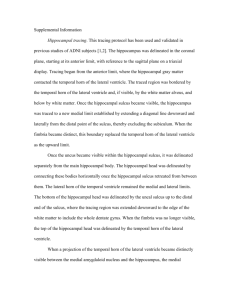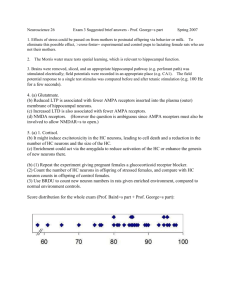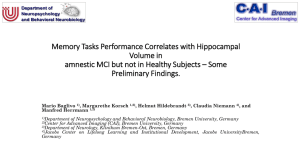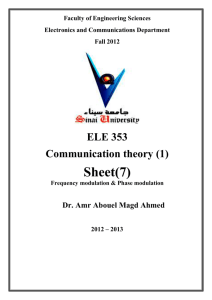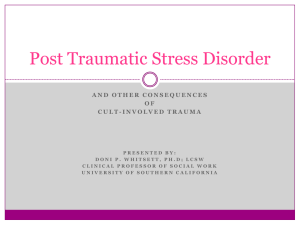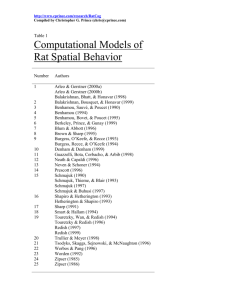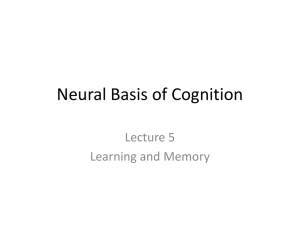Is FDG PET or volumetric MRI hippocampal - HAL
advertisement
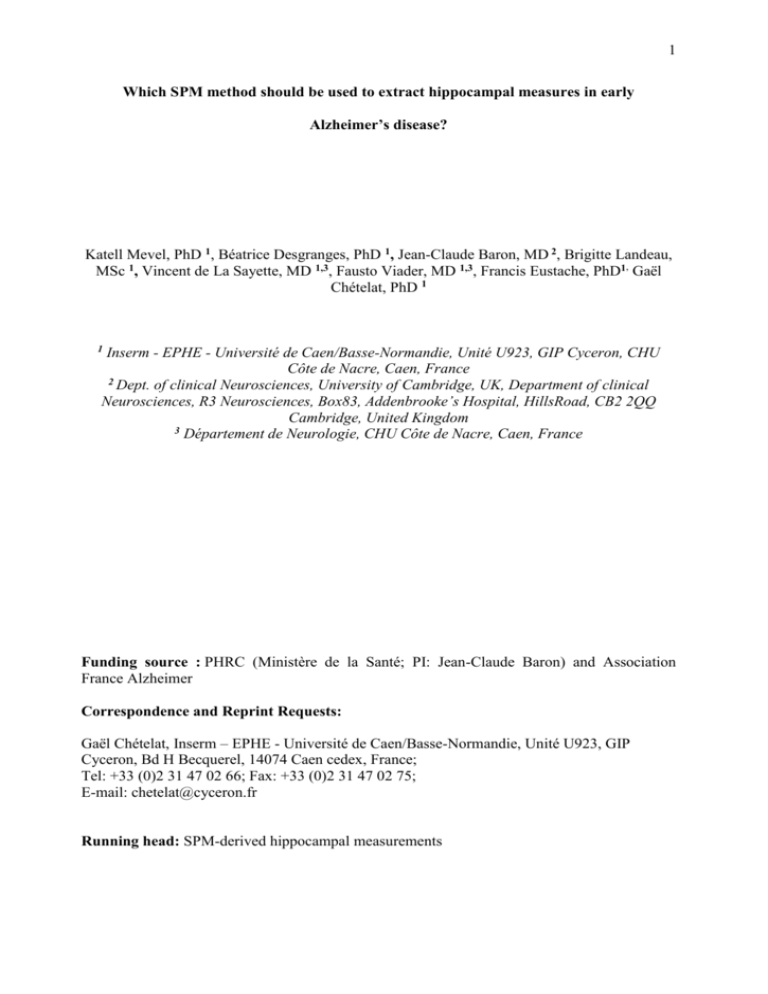
1 Which SPM method should be used to extract hippocampal measures in early Alzheimer’s disease? Katell Mevel, PhD 1, Béatrice Desgranges, PhD 1, Jean-Claude Baron, MD 2, Brigitte Landeau, MSc 1, Vincent de La Sayette, MD 1,3, Fausto Viader, MD 1,3, Francis Eustache, PhD1, Gaël Chételat, PhD 1 1 Inserm - EPHE - Université de Caen/Basse-Normandie, Unité U923, GIP Cyceron, CHU Côte de Nacre, Caen, France 2 Dept. of clinical Neurosciences, University of Cambridge, UK, Department of clinical Neurosciences, R3 Neurosciences, Box83, Addenbrooke’s Hospital, HillsRoad, CB2 2QQ Cambridge, United Kingdom 3 Département de Neurologie, CHU Côte de Nacre, Caen, France Funding source : PHRC (Ministère de la Santé; PI: Jean-Claude Baron) and Association France Alzheimer Correspondence and Reprint Requests: Gaël Chételat, Inserm – EPHE - Université de Caen/Basse-Normandie, Unité U923, GIP Cyceron, Bd H Becquerel, 14074 Caen cedex, France; Tel: +33 (0)2 31 47 02 66; Fax: +33 (0)2 31 47 02 75; E-mail: chetelat@cyceron.fr Running head: SPM-derived hippocampal measurements 2 Abstract: Background & Purpose: To provide guidance regarding the preferred Voxel Based Morphometry (VBM) -derived method for assessing hippocampal atrophy in early Alzheimer’s disease (AD). Methods: T1-MRI volume data were collected in twenty-three patients with amnestic Mild Cognitive Impairment (aMCI) and eighteen controls. Three types of data (unmodulated and two types of modulated MRI) and two extraction methods (with reference to the hippocampal peak of atrophy identified from a preliminary whole-brain analysis, or using a template Region of Interest - ROI - approach) were compared to the gold-standard individual ROI (ROI-i) method through two statistical approaches (ANOVA and Pearson’s R). Results: First, whole-brain analyses performed on modulated data are as sensitive as the ROI-i approach in detecting aMCI patients’ hippocampal atrophy. Second, values extracted from the ROItemplate applied to modulated data provide measures of hippocampal volume comparable to those obtained using the ROI-i approach. Conclusions: The present study provides guidance on how to extract accurate hippocampal measures from VBM-derived data in early AD, as a timesaving and easy alternative to the reference ROI-i method. Key words: Hippocampus, Neuroimaging, Mild Cognitive Impairment, MRI, Voxel Based Morphometry, Region Of Interest 3 Introduction: The hippocampus is a key brain area in Alzheimer’s disease (AD) as it is the site of highest and earliest neuropathological and structural alterations, including neurofibrillary tangles, neuronal loss and atrophy on brain imaging.1,2,3 Furthermore, hippocampal atrophy is a consistent feature in amnestic Mild Cognitive Impairment (aMCI), a clinical entity that best represents the predementia stage of AD.4 Hippocampal atrophy has been shown to be associated with increased risk of developing clinical probable AD in aMCI,1,3,5 and is considered a supportive feature for the clinical diagnosis of AD. Over and above detection of hippocampal atrophy for clinical purposes, hippocampal size measurement is also used to assess its relationships with other AD-related brain or cognitive changes in order to better understand the causes and consequences of this early pathologic process.6,7 Although other automatic or semi-automatic methods of hippocampal segmentation have been developed over the past decade,8,9,10 the two main methods currently used to assess hippocampal atrophy are i) individual manual Region of Interest (ROI-i) and ii) Voxel Based Morphometry (VBM) using Statistical Parametric Mapping (SPM). The latter is widely used as an automatic voxel-based method, whereas the former more labour-intensive yet is considered as the gold-standard. The validity of VBM to assess hippocampal atrophy has been debated, due to the spatial normalization and smoothing steps required for voxel-based group analyses that may compromise the measure of atrophy in small and complex structures such as the hippocampus. A few studies have been conducted to compare the sensitivity of VBM versus the ROI-i approaches for the detection of hippocampal atrophy in AD,11,12 and in fact the findings overall argue for the validity of VBM, showing at least comparable sensitivity for both approaches. However, quantitative measures for hippocampal volume using VBM can be extracted in different ways and from different kinds of VBM-derived images. Thus hippocampal volume 4 can be extracted either directly from gray matter (GM) density maps or using VBM-toolbox, from two different types of modulated GM volume datasets (see below). In addition, quantitative measures can then be extracted either by superimposing a ROI of the hippocampus traced on a customized template onto VBM-derived images, or using the peak value of hippocampal atrophy identified through a preliminary whole brain analysis.13,14 Thus our objective with the present study is to give further insight onto the different measures provided by this widely used automatic technique. More specifically, our main goal is to validate and designate the most appropriate VBM-derived technique(s) to assess the degree of hippocampal atrophy in early AD and the relationships between hippocampal volume and cognitive or other brain changes. To this end, the different VBM methods mentioned above were compared to the reference ROI-i approach. Two different types of statistical approaches were conducted. The first one used ANOVAs, as well as Receiver Operating Characteristic (ROC) curves and Area Under the Curve (AUC) comparison analyses, to compare the sensitivity of the different methods in detecting hippocampal atrophy in early AD. The second one used correlations to identify the method whose values best correlate with those obtained with the gold-standard ROI-i approach. Materials and methods Participants Subjects' characteristics are summarized in Table 1. A total of 41 right-handed subjects were studied, including 23 patients with aMCI and 18 healthy elderly. aMCI patients were prospectively recruited through a memory clinic, which they all attended for a complaint of memory impairment. At the time of the study, none of the patients was or had been treated with specific medication such as anti-acetylcholinesterase agents. Following extensive medical, neurological, neuropsychological, and neuroradiological investigations, they were selected 5 according to stringent criteria for aMCI, i.e. isolated objective episodic memory deficits (performances 1.5 SD below the normal mean for age-matched controls in at least one episodic memory test) with preservation of other cognitive domains, activities of daily-living and global cognitive capacities, age over 55 years and NINCDS-ADRDA criteria for probable AD not met.15 The 18 unmedicated healthy elderly had no cerebrovascular risk factors, mental disorder, substance abuse, history of head trauma and significant abnormalities in standard MRI or biological tests. During the follow-up period (ranging from 18 to 36 months), none of the healthy controls converted to either aMCI or dementia; 8 aMCI patients converted to AD, 14 were still classified as aMCI, and one was unclassified because of incomplete follow-up information. The overall rate of conversion in aMCI patients was thus 23% per year. Finally, all subjects included in this study gave informed consent for the protocol, which was approved by the Regional Ethics Committee. Neuroimaging procedure For each subject, a high-resolution T1-weighted volume MRI scan was obtained, which consisted of a set of 128 adjacent axial cuts parallel to the AC–PC line and with slice thickness 1.5mm and pixel size 0.94 x 0.94mm (TR = 10.3 ms; TE = 2.1 ms; FOV = 24x18 cm; matrix = 256x192). All the MRI data sets were acquired on the same scanner (1.5 T Sigma Advantage echospeed; General Electric). Briefly, as mentioned in the introduction, we used individual ROI measurements and three types of VBM-derived data (unmodulated, m_modulated and m0_modulated), and two different statistical approaches to extract quantitative measures of hippocampal volumetry from these VBM-derived datasets, namely from an hippocampal ROI delineated on a customized MRI template – referred to as the ROI-template (ROI-t) method, or from the peak voxel with most significant hippocampal atrophy in a preliminary whole-brain VBM analysis – referred to 6 as the Hip-peak method. These six sets of values were then first entered into six independent ANOVAs, and AUC from ROC curves were also computed, to compare their accuracy for detecting hippocampal atrophy in aMCI to that of the ROI-i gold-standard method. Second, the same six sets of values were entered in correlation analyses with the ROI-i-derived hippocampal volumes in order to identify the SPM-derived method best correlated to the ROI-i method. Individual ROI approach: Using MRIcro software,16 right and left hippocampal anatomic boundaries were drawn from anterior to posterior on native MRI sections displayed in coronal orientation. The ROI-i were delineated blinded to diagnostic group by the same experienced observer (KM) using similar tracing rules as those used in a previously published study.14 The ROI-i were traced twice by the same observer in a subsample of 14 randomly-selected participants about 3 months apart and Intraclass Correlation Coefficients (ICC) were computed to assess the reliability of the tracings. The ICC for an absolute agreement between measures (same rater for all subjects) was 0.9975 and 0.9941 for the right and left hippocampus respectively. VBM approach: MRI data were preprocessed using the VBM5 tool implemented in SPM5. This is an improved version of the standard VBM procedure described in detail elsewhere17 and already used in previous studies.18,15 Briefly, it includes the standard bias correction, spatial normalization onto the MNI template, and segmentation steps, but instead of each step being performed serially as previously, they are combined / alternated in VBM5, allowing more accurate estimations. Computing our original MRI data sets through the VBM5 process, we obtained spatially normalized unmodulated GM density images as well as the two different kinds of modulated images. Modulation allows compensating for the effect of spatial normalization that causes volume changes due to both affine transformation (global scaling) and non-linear warping (local volume change). Correcting for both effects would result in 7 images with values reflecting volumes before spatial normalization, that therefore need to be corrected for Total Intracranial Volume (TIV) to take into account brain size variability. This is the usual way of modulating the data previously described in detail,17,19 which will be referred to m_modulated data in what follows. An alternative modulation method is available in VBM5, which consists in correcting for non-linear warping only. Its advantage is that TIV does not need to be taken into account in subsequent analyses. This method is referred to as m0_modulation in what follows. All normalized MRI datasets were then masked to exclude potential remaining non-GM voxels. The mask was obtained by thresholding the mean image of both populations’ normalized GM partitions above a value of 0.2, corresponding to a 20% chance for the voxel to belong to GM.6,14 TIV calculation: The TIV was automatically obtained through VBM5 and corresponded to the sum of the three intracranial segments, i.e. GM, white matter and cerebrospinal fluid. This technique has been shown to provide an accurate estimate of TIV.20 Hippocampal volume extraction: For the SPM ROI-t method, the right and left hippocampi were delineated on the mean unmodulated MRI template of the whole sample. Then, individual mean values across all the voxels included in each ROI were extracted for each condition, applying these two ROI-t to the three VBM-derived datasets. The mean voxel values extracted from m_modulated and m0_modulated data were then multiplied by the number of voxels included in the corresponding (right or left) ROI-t and only the former were divided by the TIV. With respect to the Hip-peak method, the m_modulated, m0_modulated and unmodulated MRI datasets were smoothed (FWHM=12), masked and entered in SPM5 analyses comparing controls and aMCI patients (using the “Two sample t-test” routine and introducing TIV as a covariate for the m_modulated data analysis). For each of these three analyses, we used the Small Volume Correction function (SVC21,14) to identify the hippocampal 8 voxel of most significant atrophy (Hip-peak) in each hemisphere, limiting the analysed region to the above-described hippocampal ROI-t. Using a p(FDR) < 0.05 threshold, the right and left Hip-peak MNI coordinates were [33 -38 -6] and [-20 -14 -14] for the unmodulated data, [26 -13 -17] and [-20 -14 -14] for the m_modulated data, and [26 -13 -17] and [-20 -14 -14] for the m0_modulated data, respectively. The individual right and left Hip-peak values were then extracted, and the m_modulated Hip-peak values were divided by the corresponding TIV. In sum, seven sets of individual right and left hippocampal measures were obtained; the ROI-i measures were extracted from the native space MRI data, the ROI-t values were extracted from the m_modulated, m0_modulated and unmodulated normalized GM partitions; and the Hip-peak values were extracted from the preliminary SPM group comparison analyses onto normalized m_modulated, m0_modulated and unmodulated data sets. Statistical analyses The seven sets of hippocampal measures were first centred on zero (by dividing the values by the corresponding mean of the whole sample), and then used to perform two kinds of statistical analyses, namely ANOVAs and correlations. First, six ANOVAs with two factors (Hemisphere, Method) of two levels each (Right vs. Left hippocampus; ROI-i vs. ROI-t or Hippeak from m_modulated, m0_modulated or unmodulated data sets) and two groups (Healthy Subjects and aMCI) were performed. In this study, we were more specifically interested in significant Method x Group interactions indicating a significant effect of the method on hippocampal atrophy detection in aMCI. Note that a partial Eta Squared (η2 p) index was also used to assess each effect size. Post-hoc LSD tests, correcting for multiple comparisons, were applied on significant Method x Group interactions. Furthermore, we used ROC curves to indicate the relationship between sensitivity and specificity for each intergroup discrimination. We also calculated the AUC, which is an index of overall discriminative ability, for each 9 condition in each hemisphere. Then we calculated the difference between AUCs using a z statistic 22 to highlight the VBM method with the highest discrimination accuracy. This statistical test can be used if the curves to be compared are obtained from the same cohort of individuals, and if the variables lay on a continuous or graded scale, both assumptions being met in the present study. Two AUCs were considered as significantly different when the corresponding p value was lower than 0.05. Second, correlations were also conducted between the right or left ROI-i volumes and the corresponding ROI-t or Hip-peak values (from m_modulated, m0_modulated or unmodulated data sets). Only parametric Pearson’s correlations would be detailed here but the same findings were obtained using non-parametric Spearman’s tests. Finally, there was no main effect of gender on hippocampal measurements (F(1;14)=1.16; p=0.35), so that this variable was not considered in subsequent analyses. All the results were considered as significant when p≤ 0.05. Results The six ANOVAs showed a significant main effect of Group (aMCI < controls; Table 2). No significant main effect of Hemisphere or Method was found (see supplementary Table S.1 for further details). Across ROI-t conditions, there was a significant Group x Method interaction such that voxel-based methods provided lower between-group differences, while no significant interaction was found in the Hip-peak conditions. Compared to Hip-peak conditions, η2 p values were higher with ROI-t approaches (Figure 1a and 1b; Table 2). Percent decrease of hippocampal volume in aMCI compared to controls and corresponding p-value are indicated for each condition in supplementary Table S.2. Regarding the ROC curves for intergroup discrimination in each hemisphere (Figure 2; supplementary Table S.3), the AUC indicated that the Hip-peak method used with modulated data showed the highest AUC while the lowest AUC value was obtained for the unmodulated ROI-t method. The statistical comparisons 10 between AUCs of the ROC curves indicated significant differences between unmodulated ROIt and modulated Hip-peak methods (z = 2.11, p = 0.035 for m_modulated and z = 2, p = 0.041 for m0_modulated left hippocampus values; z = 2.47, p = 0.013 for m_modulated and z = 2.39, p = 0.017 for m0_modulated right hippocampus values). No significant differences were observed between AUCs obtained with ROI-i and VBM methods in the left hemisphere, while unmodulated ROI-t AUCs significantly differed from the ROI-i ROC curve in the right hippocampus (z = 2.38; p = 0.017). The correlation analysis revealed that right or left hippocampal ROI-i volumes significantly correlated with all voxel-based methods. Higher r values were obtained with modulated data compared to unmodulated data, and for ROI-t compared to Hip-peak conditions (Table 3; Figure 1c and 1d). The highest r value was observed for the m_modulated ROI-t value (r=0.81, p = 1.06-10; Figure 1c) which remains true when removing the outlier MCI with the lowest hippocampal volume (r= 0.81, p = 2.8-10). Discussion Our findings first point to the relevance of using modulated, rather than unmodulated, GM data. Thus, unmodulated (i.e. GM density) data provided the most significant Group x Method interaction in the ANOVAs, resulted in the lowest between-group differences in term of percent decreases, were associated to the lowest AUC values and showed the lowest correlation coefficients. Altogether, these results indicate that unmodulated data yield less accurate estimates of hippocampal volume than modulated data. Second, the lack of significant Group x Method interaction when applying the Hip-peak approach onto any type of VBM-derived data suggests that this approach is as accurate as the ROI-i method in detecting hippocampal atrophy. This is also supported by the similar percent decreases obtained with these methods (nearly 14-18% for Hip-peak versus 18-20% for ROI-i), 11 which are consistent with the values usually reported in the literature (between 11 and 23% depending on criteria for MCI2,3). Thought not significantly different, the percent atrophy was still found to be higher using the ROI-i approach, as previously reported in AD.10 Secondly, AUC analyses of ROC curves pointed to the higher between-group discrimination accuracy of the Hip-peak method used with modulated data compared to the ROI-t method (especially when used with unmodulated data). Furthermore, we reported no differences between the AUC of the Hip-peak and the ROI-i, methods, suggesting that the Hip-peak approach is as accurate as the gold-standard technique in discriminating aMCI patients from healthy controls. Consistent with previous studies in AD dementia,11,12 our findings thus highlight the validity of VBM for assessing hippocampal atrophy in aMCI, the classical entity that best characterizes the pre-dementia stage of AD. This automatic approach is not only time-saving and operator-independent, but also allows for specifying the exact location of highest changes within the hippocampus. This regional specification may be of interest in detecting specific AD-related atrophic processes, since recent studies have highlighted a differential effect of AD and normal aging on hippocampal volume according to hippocampal subfields and anteriorposterior axis.18 Conversely, the significant Group x Method interaction in the ROI-i vs. ROI-t comparison for both types of modulated data documents that this approach is less sensitive than the ROI-i in detecting hippocampal atrophy in aMCI. Consistent with this idea, the percent decreases were smaller with the latter (nearly 6-11%) as compared to the former. Interestingly, the correlation analysis indicates the reverse pattern, i.e. ROI-t values better correlate with ROI-i than Hip-peak values do, which suggests that the ROI-t approach, although slightly less sensitive for the detection of hippocampal atrophy, may offer individual measures of hippocampal volume nearest those provided by the ROI-i approach. The ROI-t method using modulated data should therefore be preferred when individual hippocampal measures are desired, for instance for correlation with memory scores or glucose metabolism.6,7 12 To confirm this interpretation, we assessed the correlations between each hippocampal measures and episodic memory performances obtained in MCI patients using a verbal delayed recognition test.23 We found that almost all measures significantly correlated to episodic memory performances, but that the ROI-t method using modulated data provided the most similar correlation to that obtained using the ROI-i approach, compared to other VBM-derived methods (See supplementary Figure 3). Note that the use of coronal sections defined from the AC-PC line to delineate the hippocampus is a potential limitation of the present study. More precise hippocampal volume measurements could have been obtained if delineating the structure on sections perpendicular to the hippocampal longitudinal axis.24 Also, further studies would be needed to assess whether the same conclusions apply to other well-delimited brain structures such as the thalamus or caudate nucleus. In conclusion, our findings highlight the validity of VBM using modulated MRI data for the detection of hippocampal atrophy in group studies of early AD, as well as for extracting individual measures of hippocampal volume for specific purposes such as correlation with independent variables. While ROI-t is the preferred method for the latter, SPM whole-brain analysis was found to be as accurate as the reference ROI-i approach for assessing hippocampal atrophy in early AD, also providing specific locations of greatest atrophy within the hippocampal region. Acknowledgments: The financial support of the Inserm, the PHRC (Ministère de la Santé PI: J-C Baron) and Association France Alzheimer for this project are warmly acknowledged. We also are indebted to C. Lalevée and A. Pélerin for help with neuropsychological assessments, B. Dupuy and D. Hannequin for contribution to patient recruitment, M.H. Noël and M.C. Onfroy 13 for help with imaging data acquisition, G. Kalpouzos and V. Hubert for help with the healthy controls, G. Kalpouzos for advice, and the subjects who participated in this study. 14 References 1. Small GW, Bookheimer SY, Thompson PM, et al. Current and future uses of neuroimaging for cognitively impaired patients. Lancet Neurol 2008; 7:161-172. 2. Chételat G, Baron JC. Early diagnosis of Alzheimer's disease: contribution of structural neuroimaging. NeuroImage 2003; 18:525-541. 3. Shi F, Liu B, Zhou Y, Yu C, Jiang T. Hippocampal volume and asymmetry in mild cognitive impairment and Alzheimer's disease: Meta-analyses of MRI studies. Hippocampus 2009; 19:1055-1064. 4. Petersen RC, Stevens JC, Ganguli M, Tangalos EG, Cummings JL, DeKosky ST. Practice parameter: Early detection of dementia: Mild cognitive impairment (an evidence-based review). Report of the Quality Standards Subcommittee of the American Academy of Neurology. Neurology 2001; 56: 1133–1142. 5. Jack CR Jr, Shiung MM, Weigand SD, et al. Brain atrophy rates predict subsequent clinical conversion in normal elderly and amnestic MCI. Neurology 2005; 65: 1227-1231. 6. Villain N, Desgranges B, Viader F, et al. Relationships between hippocampal atrophy, white matter disruption, and gray matter hypometabolism in Alzheimer's disease. J Neurosci 2008 ; 28: 6174-6181. 7. De Jong LW, van der Hiele K, Veer IM, et al. Strongly reduced volumes of putamen and thalamus in Alzheimer's disease: an MRI study. Brain 2008 ;131:3277-3285. 8. Colliot O, Chételat G, Chupin M, et al. Discrimination between Alzheimer disease, mild cognitive impairment, and normal aging by using automated segmentation of the hippocampus. Radiology 2008; 248:194-201. 9. Konrad C, Ukas T, Nebel C, Arolt V, Toga AW, Narr KL. Defining the human hippocampus in cerebral magnetic resonance images--an overview of current segmentation protocols. NeuroImage 2009; 47:1185-1195. 15 10. Barnes J, Foster J, Boyes RG, et al. A comparison of methods for the automated calculation of volumes and atrophy rates in the hippocampus. NeuroImage 2008; 40: 1655-1671 11. Good CD, Scahill RI., Fox NC, et al. Automatic differentiation of anatomical patterns in the human brain: validation with studies of degenerative dementias. NeuroImage 2002; 17: 29-46. 12. Testa C, Laakso MP, Sabattoli F, et al. A comparison between the accuracy of voxel-based morphometry and hippocampal volumetry in Alzheimer's disease. J Magn Reson Imaging 2004; 19 : 274-82 13. Bokde A. Lopez-Bayo P, Meindl T, et al. Functional connectivity of the fusiform gyrus during a face-matching task in subjects with mild cognitive impairment. Brain 2006; 129: 1113-1124. 14. Mevel K, Desgranges B, Baron JC, et al. Detecting hippocampal hypometabolism in Mild Cognitive Impairment using automatic voxel-based approaches. NeuroImage 2007; 37: 18-25. 15. Chételat G, Landeau B, Eustache F, et al. Using voxel-based morphometry to map the structural changes associated with rapid conversion in MCI: a longitudinal MRI study. Neuroimage 2005; 27: 934-946. 16. Rorden C, Brett M. Stereotaxic display of brain lesions. Behavioural Neurology 2000; 12: 191-200. 17. Good CD, Johnsrude IS, Ashburner J, Henson RN, Friston KJ, Frackowiak RS. A voxelbased morphometric study of ageing in 465 normal adult human brains. NeuroImage 2001; 14: 21-36. 18. Chételat G, Fouquet M, Kalpouzos G, et al. Three-dimensional surface mapping of hippocampal atrophy progression from MCI to AD and over normal aging as assessed using voxel-based morphometry. Neuropsychologia 2008; 46: 1721–1731. 16 19. Ashburner J, Friston KJ, Voxel-based morphometry--the methods. NeuroImage 2000; 11: 805-821. 20. Pengas G, Pereira JM, Williams GB, Nestor PJ. Comparative reliability of total intracranial volume estimation methods and the influence of atrophy in a longitudinal semantic dementia cohort. J Neuroimaging 2009; 19: 37-46. 21. Friston KJ. Testing for anatomically specified regional effects. Hum Brain Mapp 1997; 5: 133–136. 22. DeLong ER, DeLong DM, Clarke-Pearson DL. Comparing the areas under two or more correlated receiver operating characteristic curves: a nonparametric approach. Biometrics 1988 ; 44 : 837-845. 23. Chetelat G, Desgranges B, de la Sayette V, et al.. Dissociating atrophy and hypometabolism impact on episodic memory in mild cognitive impairment. Brain 2003; 126:1955-1967. 24. Jack CR Jr, Theodore WH, Cook M, & McCarthy G. MRI-based hippocampal volumetrics: data acquisition, normal ranges, and optimal protocol. Magn Reson.Imaging 1995; 13: 1057-1064. 17 Table 1: Demographics and MMSE for the healthy aged controls and aMCI samples Controls aMCI n 18 23 Age: mean (SD) 67.8 (7.5) years 70.8 (7) years Range (56-84) (55-79) % Female 44 61 MMSE : mean (SD) - 27.3 (1.3) Range - (25-29) 18 Table 2: Results of the Method x Group interactions from the ANOVAs with two factors (Hemisphere, Method) and two Groups (aMCI, Controls). ROI-i vs. unmodulated ROI-t F values(1,39) η2 p p values 15.57 0.28 0.0003 * 9.36 0.19 0.004* 11.58 0.23 0.001* 2.86 0.07 0.09 ROI-i vs. m_modulated ROI-t ROI-i vs. m0_modulated ROI-t ROI-i vs. unmodulated Hip-peak ROI-i vs. m_modulated Hip-peak 0.245 ROI-i vs. m0_modulated Hip-peak 1.38 0.006 0.03 0.62 0.25 *Significant p ≤ 0.05 ; ROI-i = individual ROI ; ROI-t= ROI-template ; η2p= partial Eta Squared 19 Table 3: Results of the Pearson’s correlations between the Right and Left hippocampal ROI-i volumes and the VBM-derived methods. Left hippocampus Right hippocampus ROI-i vs. unmodulated ROI-t R = 0.62 * R = 0.62 * ROI-i vs. m_modulated ROI-t R = 0.81 * R = 0.80 * ROI-i vs. m0_modulated ROI-t R = 0.76 * R = 0.70 * ROI-i vs. unmodulated Hip-peak R = 0.58 * R = 0.50 ♠ ROI-i vs. m_modulated Hip-peak R = 0.78 * R = 0.76 * ROI-i vs. m0_modulated Hip-peak R = 0.73 * R = 0.67 * * Significant p < 0.0001; ♠ Significant p < 0.01 ROI-i = individual ROI; ROI-t = ROI template

